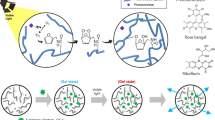Abstract
In this study, spherical alginate beads containing pyranine (P y ) as a fluorescence probe were prepared by ionotropic gelation of a sodium alginate solution. The steady state fluorescence technique was used to study pyranine release from the alginate beads crosslinked with calcium, barium and aluminum ions, respectively. The slow release of P y was observed with the time drive mode of the spectrophotometer at 512 nm. Fluorescence emission intensity (I p ) from P y was monitored during the release process, and the encapsulation efficiency (EE) of pyranine from the alginate beads was calculated. The Fickian Diffusion model was used to measure the release coefficients, D sl . It was seen that the slow release coefficients of pyranine from the alginate beads crosslinked with Ca2+, Ba2+, and Al3+ ions increased in the following order: D sl (Al3+)> D sl (Ca2+)> D sl (Ba2+). In contrast, the initial amount of pyranine and EE into the beads showed the reverse behavior.






Similar content being viewed by others
References
Papageorgiou SK, Kouvelos EP, Favvas EP, Sapalidis AA, Romanos GE, Katsaros FK (2010) Metal–carboxylate interactions in metal–alginate complexes studied with FTIR spectroscopy. Carbohydr Res 345:469–473
Grant GT, Morris ER, Rees DA, Smith PJC, Thom D (1973) Biological interactions between polysaccharides and divalent cations: the egg-box model. FEBS Lett 32:195–198
Kikuchi A, Kawabuchi M, Sugihara M, Sakurai Y, Okano T (1997) Pulsed dextran release from calcium-alginate gel beads. J Control Release 47:21–29
Işıklan N, İnal M, Kurşun F, Ercan G (2011) pH responsive itaconic acid grafted alginate microspheres for the controlled release of nifedipine. Carbohydr Polym 84:933–943
Bierhalz AKC, da Silva MA, Kieckbusch TG (2012) Natamycin release from alginate/pectin films for food packaging applications. J Food Eng 110:18–25
Banerjee A, Nayak D, Lahiri S (2007) Speciation-dependent studies on removal of arsenic by iron-doped calcium alginate beads. Appl Radiat Isot 65:769–775
Tezcan F, Günister E, Özen G, Erim FB (2012) Biocomposite films based on alginate and organically modified clay. Int J Biol Macromol 50:1165–1168
Darrabie MD, Kendall WF, Opara EC (2006) Effect of alginate composition and gelling cation on microbead swelling. J Microencapsul 23:613–621
Mørch YA, Donati I, Strand BL, Skjåk-Braek G (2006) Effect of Ca2+, Ba2+ and Sr2+ on alginate microbeads. Biomacromolecules 7:1471–1480
Anal AK, Stevens WF (2005) Chitosan–alginate multilayer beads for controlled release of ampicillin. Int J Pharm 290:45–54
Cook MT, Tzortzis G, Charalampopoulos D, Khutoryanskiy VV (2012) Microencapsulation of probiotics for gastrointestinal delivery. J Control Release 162:56–67
Chretien C, Chaumeil JC (2005) Release of a macromolecular drug from alginate-impregnated microspheres. Int J Pharm 304:18–28
Nochos A, Douroumis D, Bouropoulos N (2008) In vitro release of bovine serum albumin from alginate/HPMC hydrogel beads. Carbohydr Polym 74:451–457
Torre ML, Maggi L, Vigo D, Galli A, Bornaghi V, Maffeo G, Conte U (2000) Controlled release of swine semen encapsulated in calcium alginate beads. Biomaterials 21:1493–1498
Abd El-Ghaffar MA, Hashem MS, El-Awady MK, Rabie AM (2012) pH-sensitive sodium alginate hydrogels for riboflavin controlled release. Carbohydr Polym 89:667–675
Tanaka H, Irie S (1988) Preparation of stable alginate beads in electrolyte solutions using Ba2+ and Sr2+. Biotechnol Tech 2:115–120
Şanlı O, Işıklan N (2006) Controlled release formulations of carbaryl based on copper alginate, barium alginate, and alginic acid beads. J Appl Polym Sci 102:4245–4253
Torre ML, Faustini M, Norberti R, Stacchezzini S, Maggi L, Maffeo G, Conte U, Vigo D (2002) Boar semen controlled delivery system: storage and in vitro spermatozoa release. J Control Release 85:83–89
Nokhodchi A, Tailor A (2004) In situ cross-linking of sodium alginate with calcium and aluminum ions to sustain the release of theophylline from polymeric matrices. Il Farmaco 59:999–1004
Gan BS, Krump E, Shrode LD, Grinstein S (1998) Loading pyranine via purinergic receptors or hypotonic stress for measurement of cytosolic pH by imaging. Am J Physiol Cell Physiol 275:C1158–C1166
Mondal SK, Sahu K, Sen P, Roy D, Ghosh S, Bhattacharyya K (2005) Excited state proton transfer of pyranine in a γ-cyclodextrin cavity. Chem Phys Lett 412:228–234
Evingür GA, Tezcan F, Erim FB, Pekcan Ö (2012) Monitoring the gelation of polyacrylamide-sodium alginate composite by fluorescence technique. Phase Transit 85:530–541
Pekcan Ö, Tari Ö (2004) A fluorescence study on the gel-to-sol transition of κ-carrageenan. Int J Biol Macromol 34:223–231
Pekcan Ö, Kara S (2005) Cation effect on thermal transition of iota-carrageenan: a photon transmission study. J Biomater Sci Polym Ed 16:317–333
Kara S, Arda E, Pekcan Ö (2007) Monovalent and divalent cation effects on phase transitions of ı-carrageenan. J Bioact Compat Polym 22:42–61
Evingür GA, Karslı K, Pekcan Ö (2006) Monitoring small molecule diffusion into hydrogels at various temperatures by fluorescence technique. Int J Pharm 326:7–12
Ataman E, Pekcan Ö (2007) Small molecule diffusion into swelling Iota-Carrageenan gels: a fluorescence study. J Biomol Struct Dyn 24:505–513
Evingür GA, Pekcan Ö (2007) Sorption and slow release kinetics of PAAm gels at various temperatures. J Polym Eng 27:583–595
Kara S, Gacal B, Tunç D, Yağcı T, Pekcan Ö (2012) Sorption and desorption of PVA-Pyrene Chains in and out of Agarose gel. J Fluoresc 22:1073–1080
Crank J (1975) The mathematics of diffusion. Clarendon, Oxford
Crank J, Park GS (1968) Diffusion in polymer. Academic, London
Bajpai SK, Sharma S (2004) Investigation of swelling/degradation behavior of alginate beads crosslinked with Ca2+ and Ba2+ ions. React Funct Polym 59:129–140
Acknowledgments
Experiments were carried out at the Spectroscopy Laboratory of the Department of Molecular Biology and at the Capillary Electrophoresis Laboratory of the Department of Chemistry at Istanbul Technical University.
Author information
Authors and Affiliations
Corresponding author
Rights and permissions
About this article
Cite this article
Kaygusuz, H., Erim, F.B., Pekcan, Ö. et al. Cation Effect on Slow Release from Alginate Beads: A Fluorescence Study. J Fluoresc 24, 161–167 (2014). https://doi.org/10.1007/s10895-013-1282-y
Received:
Accepted:
Published:
Issue Date:
DOI: https://doi.org/10.1007/s10895-013-1282-y




